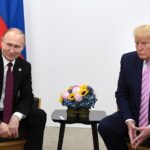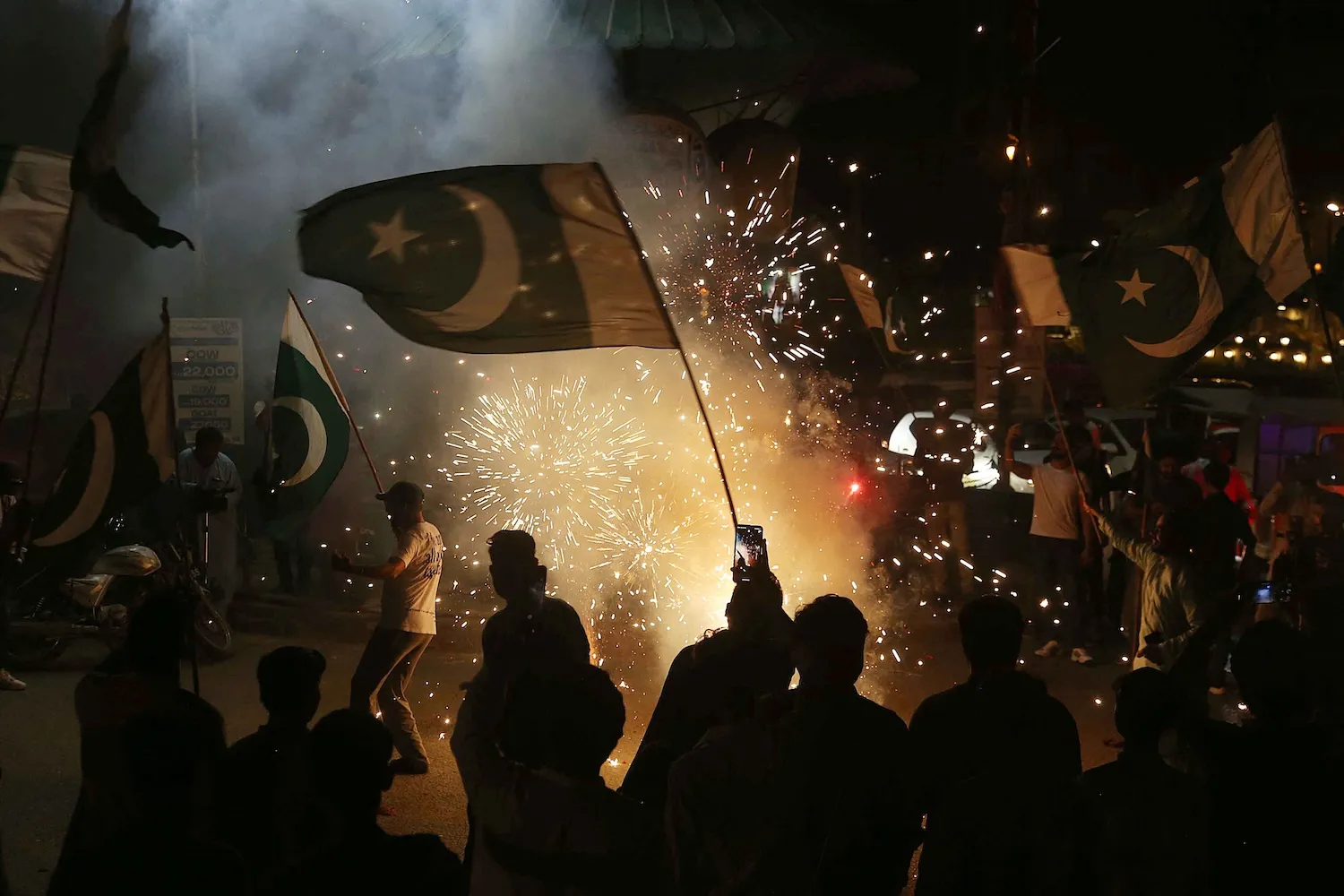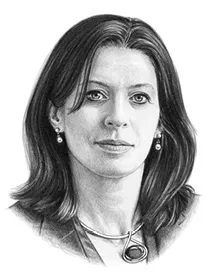A European Peacekeeping Force in Ukraine Won’t Work

A European Peacekeeping Force in Ukraine Won’t Work
Any plan needs NATO involvement to be credible.
People walk along a street past a mural dedicated to Oleksandr Khmil, a former hockey player and coach killed in battle against Russian troops, in Kyiv on May 15. Genya SavilovAFP via Getty Images
European leaders have been attempting for months to design a “coalition of the willing” peacekeeping force to Ukraine, potentially ranging from 10,000 to 40,000 troops from the European Union and United Kingdom, should a cease-fire with Russia take hold. Billed as a show of unity and European resolve, the proposal has been particularly championed by the U.K. and France—and there have been credible leaks suggesting that a security deal between the U.K. and Europe is coming soon.
But this plan is likely to be heavy on symbolism and dangerously light on credibility. Without major reinvestment in national military and logistics capabilities and the bona fide leadership of NATO, any such underpowered European force will leave the continent politically, militarily, and strategically vulnerable. A miscalculated European peacekeeping posture could easily be exploited by Moscow and ultimately weaken Europe’s standing yet further.
European leaders have been attempting for months to design a “coalition of the willing” peacekeeping force to Ukraine, potentially ranging from 10,000 to 40,000 troops from the European Union and United Kingdom, should a cease-fire with Russia take hold. Billed as a show of unity and European resolve, the proposal has been particularly championed by the U.K. and France—and there have been credible leaks suggesting that a security deal between the U.K. and Europe is coming soon.
But this plan is likely to be heavy on symbolism and dangerously light on credibility. Without major reinvestment in national military and logistics capabilities and the bona fide leadership of NATO, any such underpowered European force will leave the continent politically, militarily, and strategically vulnerable. A miscalculated European peacekeeping posture could easily be exploited by Moscow and ultimately weaken Europe’s standing yet further.
The political motivations behind the EU-U.K. peacekeeping proposal are clear. With the White House aggressively pushing for negotiations to end the war, no matter how punishing the peace for Ukraine, EU nations have found themselves sidelined in high-level peace talks while also shouldering a larger proportion of military aid.
British Prime Minister Keir Starmer and French President Emmanuel Macron see the proposed deterrence force as a means to ensure that Europe has a seat at the table and a stake in enforcing any peace—and to signal to U.S. President Donald Trump, albeit belatedly, that the United States will no longer have to do the heavy lifting alone. The European force proposal is partly a response to the fear that U.S. support can no longer be taken for granted.
Within the coalition, there are also intra-European political motives. In Britain, the post-Brexit government is eager to show that the U.K. can still lead in European security matters alongside the EU—seen by Starmer as part of his “reset” in relations with the bloc after years of animosity. For France, the plan aligns with Macron’s long-standing vision of greater European “strategic autonomy” in defense, the embryonic first test case for a European army. London and Paris can symbolically display European unity—and please voters.
Some 58 percent of British voters would like to see the British Army involved as peacekeepers, compared with only 21 percent who oppose the plan. Similar numbers in France support a peacekeeping force but overwhelmingly oppose using French forces on the front line. Some 73 percent of the French public believes that the United States is no longer a French ally.
Thus, while there is a clear attempt to demonstrate their relevance after decades of underfunding and undermanning their militaries, this does not mean that the gravity of the situation is lost on British and European leaders. A leaked draft of the reported EU-U.K. security deal shows that Europe understands that it faces the “greatest threat in a generation.” European military aid to Ukraine remains robust—with Germany leading in providing some 11 billion euros (about $12.3 billion) in the latest tranche of aid announcements. But this same seriousness has not been evident when it comes to the deterrence force.
Speaking to the Telegraph in March, a senior British military source bluntly described the plan as “political theatre” without a “defined military end-state.” With Starmer’s talk of a “coalition of the willing” with “planes in the air and boots on the ground,” the source quipped that the prime minister “got ahead of himself with talk of boots on the ground before he knew what he was talking about,” noting that London has since shifted emphasis to more attainable contributions such as air and naval patrols, “which are easier to do and don’t need basing in Ukraine.”
The need for a political statement came first, so the realities of logistical and manpower shortages at a continental scale had to come second.
Peacekeepers reassure Ukraine and hawks in Europe that any peace deal will not abandon Kyiv. They counter a clear and reasonable fear that a cease-fire could simply freeze the conflict, allow Russia time to consolidate, and leave Ukraine vulnerable.
The idea of peacekeepers is meant to signal to Ukraine that Western troops would stand guard and to Russia that any breach of peace would be met with an international military response. Jack Watling of the Royal United Services Institute told The Associated Press in March that the Western force’s purpose would be to “give Ukraine confidence that a violation of the ceasefire would lead to the Russians having to contend with European forces, and in particular European air power.”
If an effective peacekeeping force were deployed, it would temper Russian President Vladimir Putin’s ambitions in a single stroke. To the extent that Putin foresees a viable peacekeeping force, he has an incentive not to seek peace, which would crystallize such a force on his border. It could only really be seen as a disincentive for peace.
Such a peacekeeping force, at the scale of relevance for a full-scale war across the flat expanse of the Eurasian steppe, would have to be historically large, around 80,000 troops plus reserves, to fulfill its strategic role and offer any defense against the Russian army. Ukraine insists, as it should, that the force must contain anti-drone, anti-air, and missile defense systems. It would have to be organized and constructed of the various nationalities in a unified command, be able to be resupplied in the event of war, and to support the Ukrainian army in combined-arms operations.
While the notional size of the peacekeeping force ranges from 10,000 up to perhaps 30,000 or 40,000 troops, even the lower end of this spectrum is proving difficult for Europe to muster. European countries would reportedly “struggle” to collectively deploy even 25,000 peacekeepers to Ukraine, according to an April report in the Times. Despite dozens of nations expressing general support for the idea, hard commitments of combat troops are scant.
Britain and France have each signaled a willingness to contribute on the order of 5,000-10,000 personnel at most. But other major nations—Germany, Italy, Spain, and Poland among them—have indicated that they will not send any soldiers from their own armies for such a mission. Without them, “it is a dead end,” one source told the Times.
This shortfall became apparent when Britain’s military chief, Adm. Sir Tony Radakin, initially floated the idea of deploying 64,000 peacekeepers. Fellow defense ministers across Europe balked; there was “no chance” of reaching that number. To sustain a 64,000-strong force in the field long-term, European armies would realistically need to muster the practically impossible number of 256,000 troops in total to account for rotation cycles and rest periods.
The decades of underinvestment and downsizing have left European militaries, with the exception of Poland and the Baltic states, with only a token deployable strength. The land forces of key NATO states in Europe have shrunk dramatically since the Cold War, and many of their personnel are tied up in base deployments, training, or other missions.
Estonia and Finland have been especially vocal that they cannot weaken their own border guard. Baltic leaders also oppose any plan to redeploy the NATO battlegroups currently stationed in Estonia, Latvia, and Lithuania to Ukraine as part of the peacekeeping effort. Those NATO forward battalions, largely composed of other allied troops, are considered vital tripwires deterring Russia at the Baltic frontier. Moving them would leave the northeastern flank exposed—an unacceptable trade-off.
The supporting infrastructure and equipment required for a large deployment are also simply not available. Modern military operations need extensive logistics, transport aircraft, helicopters, medical evacuation units, intelligence and surveillance systems, and more. Europe is deficient in each of these auxiliary capabilities and relies on the logistical muscle of the United States in NATO operations. For example, airlift capacity to move thousands of troops and heavy gear into Ukraine would be limited without U.S. C-17 cargo planes.
Every European country privately worries about the risks of putting their own soldiers in harm’s way on Ukrainian soil, where a broken cease-fire could see peacekeepers quickly overwhelmed and potentially encircled—and potentially acting as a tripwire that would lead to angry public demand for further intervention. Indeed, a deployment of only 5,000 British soldiers, a single brigade, would require a rotation of four brigades, which would consume nearly half of the total usable manpower of the British Army.
On the flip side, Russia would be incensed by more NATO forces on the border, and it would vindicate Russian propaganda that an imperialist Western alliance seeks to destroy Russia.
In the unlikely event that Russia formally accepts a limited peacekeeping arrangement, it could still use proxies or “deniable” mercenary forces to harass it. If Europe’s response is weak or divided, Russia will have succeeded in both undermining the peace and exposing European disunity.
The trouble now is that Europe has already committed itself to this idea—not the wrong idea a priori but one that Europe cannot pull off alone and would be a strategic blunder if it tried. Yet there is no putting this genie back in the bottle: To abandon plans at this point would only advertise Europe’s weakness and division. Europe is going to pursue this plan despite the likelihood that it simply distracts from the substantive military rearmament that is required.
So, how can this be handled in a way that projects power, rather than vulnerability? The first point Britain and France must clarify is whether these likely 10,000 troops would simply be stationed in western Ukraine, far from any potential flashpoint (perhaps around Lviv or other safer areas), as a token presence. If so, what deterrent value would that really have, being more than 250 miles from the front line?
If peacekeepers are expected to patrol buffer zones or the edges of a conflict line, are they prepared to face hostile fire or attacks by rogue actors? What are their rules of engagement? If they are fired on, is there a credible general mobilization that could come to their aid within a short enough time frame? This fundamental half-heartedness is at the core of U.S. envoy Steve Witkoff’s critique of the idea as “simplistic” and a mere “posture and a pose.” A key feature of the deterrent must be that firing on these troops would trigger NATO’s Article 5 collective defense clause—which would require a skeptical United States to be on board.
Starmer himself has emphasized that the coalition would require “strong U.S. backing” to succeed—likely in terms of reserve forces or guarantees to step in if things go wrong. This all points toward a single political and military solution: a NATO-flagged deployment with NATO (read: U.S.) generals commanding a small force composed largely of British and French troops. Trump would retain leadership in a key NATO theater without a significant new U.S. presence.
The group must aim to serve principally as air support and in surface-to-air missile defenses and specialist countermeasures that can be operated from well behind the front lines. The promise of a European presence can be met by offering auxiliary support to Ukraine’s armed forces, rather than by troop numbers.
Rather than pinning hopes on a hasty and underpowered coalition, European leaders should use this moment to double down on strengthening NATO and their own militaries at the national level. The hard truth is that NATO remains the bedrock of Europe’s defense and only a NATO-integrated effort can marshal the scale and cohesion required to truly deter Russia.
More from Foreign Policy
-

Indian Air Force personnel stand in front of a Rafale fighter jet during a military aviation exhibition at the Yelahanka Air Force Station in Bengaluru. A Tale of Four Fighter Jets
The aircraft India and Pakistan use to strike each other tell a story of key geopolitical shifts.
-

A cardinal in a black robe with red sash with hands folded in front of him walks past a stage and steps. Conclave Sends Message With American Pope
Some cardinals had been agitating for U.S. leadership to counter Trump.
-

An illustration shows red tape lines crossing over and entrapping a semiconductor chip. Is It Too Late to Slow China’s AI Development?
The U.S. has been trying to keep its technological lead through export restrictions, but China is closing the gap.
-

A man watches a news program about Chinese military drills surrounding Taiwan, on a giant screen outside a shopping mall in Beijing on Oct. 14, 2024. The Pentagon Fixates on War Over Taiwan
While U.S. military leaders fret about China, Trump has dismissed the Asia-Pacific.











Join the Conversation
Commenting on this and other recent articles is just one benefit of a Foreign Policy subscription.
Already a subscriber?
.
Subscribe
Subscribe
View Comments
Join the Conversation
Join the conversation on this and other recent Foreign Policy articles when you subscribe now.
Subscribe
Subscribe
Not your account?
View Comments
Join the Conversation
Please follow our comment guidelines, stay on topic, and be civil, courteous, and respectful of others’ beliefs.
Change your username |
Log out
Change your username:
CANCEL
Confirm your username to get started.
The default username below has been generated using the first name and last initial on your FP subscriber account. Usernames may be updated at any time and must not contain inappropriate or offensive language.